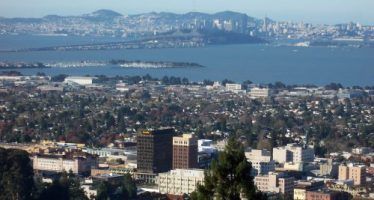SMUD’s Creative Rate Increase Lingo
Katy Grimes: The Sacramento Municipal Utility District is changing some of its rate terminology in order to charge higher rates. The utility company claims that it really is “an effort to better define for customers what they are paying for and why, to introduce customers to some new concepts, and to prepare for the future.”
Ahhh. SMUD wants to prepare rate payers for the future. I know that I feel better about my $370 electric bill.
This is the garbage bureaucrats think will pass muster with rate payers. Last year at this time, my electric bill was about $100 less. The same has happened with my PG&E bill – both are inexplicably higher, and during a much warmer, dryer winter.
For your reading pleasure, I’ve copied the entire “2012 Rate Restructuring: frequently asked questions.” I’ve added a few of my own thoughts and comments (in red), where the SMUD creative writing surpassed even Harlequin Romance novel standards.
Reader Warning: Be careful – you may need a barf bag before you finish. I hope SMUD didn’t pay a PR firm to write this drivel.
“Rate Restructuring,” in the words of SMUD:
Why is SMUD proposing to restructure its rates?
SMUD wants its rates and charges to better align with the costs they are meant to reflect, including the cost of electricity and the cost of maintaining the infrastructure that supports a reliable power-delivery system. Proposed changes would move charges closer to that ideal. The “ideal” of a reliable power delivery system involves proposed changes that involve higher rates. I get it.
For small commercial customers, a key part of the proposed restructuring is to have rates better reflect the cost of electricity when it is used. This would encourage customers to reduce usage during the summertime hours of peak demand, when electricity is most expensive. Read the general manager’s report on rates and services.
The small commercial customer will take the biggest hit – as usual. They don’t have high-paid lobbyists or big unions to fight back. And don’t forget the rate payers in higher socioeconomic zip code areas.
Given all of the subsidies, discount programs and free government stuff to low-income households, the middle class neighborhoods are probably bringing home a great deal less – especially since we are taxed on our earned income.
Is SMUD doing this to increase its revenues?
No. (Of course not) The proposed restructuring is designed to be “revenue neutral” for SMUD. It would not be a general rate increase, and it would not produce any increase in SMUD revenues. However, the restructuring could impact some customers because components of the rates are changing. SMUD has done it this way, and used this creative language so that no one will notice that they are not subject to CPUC oversight with a general rate case hearing… not that anyone should ever be subject to CPUC oversight…
“Revenue neutral” is secret code language for we are hiding the increase elsewhere, but rest assured, we will eventually collect.
What are the most significant elements of SMUD’s proposal to restructure rates?
SMUD is proposing small increases in fixed monthly service charges to recover a higher proportion of the total infrastructure costs associated with providing service to residential and small commercial customers. These costs include equipment such as wires, poles, transformers, and substations. (Medium and large commercial customers already pay closer to their proportionate share of these fixed costs in monthly charges that don’t depend on how much electricity they use.) You won’t notice a “small increase,” right?
To offset the increase in the fixed service charge and minimize impacts on residential customers, SMUD would slightly reduce its kilowatt-hour prices for electricity usage. In addition, SMUD would shorten the summer billing season from six months to four months (June through September). Rates per kWh will continue to be higher in the summer billing season than the rest of the year, reflecting market costs. Only a utility bureaucracy can “shorten the summer billing season.” Even Mother Nature can’t do that.
For all small commercial customers, SMUD is proposing “time-of-use” rates. Customers would be charged more for power between the peak usage hours of 3 and 6 p.m. on weekdays in summer, when electricity is most expensive. SMUD would shorten the summer billing season and reduce the kWh price of electricity on all “off peak” hours.
SMUD proposes to institute a late fee of 1.5 percent on the current amount due if SMUD does not receive full payment within three business days of the due date on the bill. And if you don’t pay within 3 business days, Rocko and Guido might make a collection visit.
How would rate restructuring affect customers’ bills? Duh – the bills are going up, and some by as much as 50 percent. Just ask those small commercial customers…
Most customers would see very little change in their electricity bills on an annual basis, and SMUD rates would remain more than 20 percent lower than PG&E’s electricity rates on average.
SMUD projects that in 2012 the average bill impact for approximately 90 percent of all residential customers will be less than $2 a month. Some residential customers would save money on an annual basis. Eighty-seven percent of residential customers who have electric heat would see bill changes averaging less than $2 a month. Who will save money? Low-income rate payers? Solar customers? Government offices?
Seventy-five percent of small commercial customers (drawing 21 to 299 kilowatts) and 7.5 percent of very small commercial customers (drawing less than 21 kW) would save money in 2012 under the proposed changes. For 95 percent of the very small commercial customers, bill impacts would be less than $10 a month on an annual basis. My husband owns several small commercial warehouses – his SMUD rate just went up this billing cycle by 50 percent, and one-half of the buildings are empty.
For information on projected bill impacts beyond 2012, see Addendum 2 to theGeneral Manager’s Report and Recommendation on Rates and Services.
What types of customers are apt to have higher electric bills under the proposal?
Small and very small commercial customers who use a lot of power during the peak hours of 3 to 6 p.m. on weekdays in the summer billing season (June through September) – when electricity is most expensive – could have higher bills on an annual basis unless they shift power consumption to off-peak hours. What about certain zip codes, and small business owners with empty buildings?
Residential customers who have gas heat and use very little electricity may pay slightly higher bills because of a proposed increase in the fixed monthly charge, which is designed to recover more of the fixed costs of the infrastructure for the power delivery system. For these customers, the maximum impact in 2012 would be $2.80 a month. Brilliant! Penalize customers who use less electricity.
Eighty-seven percent of residential customers who have electric heat would see bill changes averaging less than $2 a month.
To encourage energy efficiency, customers on the Energy Assistance Program Rate (a discount rate for qualifying low-income residents) will pay the standard rate for electricity use that exceeds their “base usage” plus 600 kilwatt-hours a month. (Base usage is 700 kWh in the summer billing season and 620 kWh the rest of the year for customers with gas heat.)
How would low-income customers on the Energy Assistance Program Rate be affected by the proposal? blah blah blah blah blah
SMUD projects that 90 percent of these customers would save money in 2012, while the 10 percent who have energy use that exceeds the discount cap will see their bills go up if they don’t reduce their power usage. Of course they will save because I am going to be paying a bigger part of their share, along with very small and small businesses.
Customers on the low-income rate would continue to get a 35 percent discount on base electricity usage and a 30 percent discount on up to 600 kWh of additional (“base-plus”) electricity usage in any given month. Hey! I am a member of the historically low-paid media… what about a discount for us? For electricity usage in excess of that, customers would pay the standard residential rate. This proposal was designed to encourage energy efficiency. (Base usage is 700 kWh in the summer billing season and 620 kWh the rest of the year for customers with gas heat.) These customers would see no change in their fixed monthly service charge of $3.50 in 2012.
Beginning in 2013, the fixed monthly charge would increase $1 each year, topping out at $8.50 in 2017, and there would be a corresponding decrease in kwh charges for electricity use. For information on projected bill impacts beyond 2012, see Addendum 2 to the General Manager’s Report and Recommendation on Rates and Services.
Skip this section – this will only make you crazy.
Overall, proposed changes in Energy Assistance Program Rates would be “revenue neutral” for SMUD, meaning the changes would neither increase nor reduce the revenue SMUD collects from this group of customers.
Will SMUD do anything to help customers who might have higher bills as a result of rate restructuring?
SMUD encourages customers to take advantage of its wide range of programs to improve energy efficiency. For all residential customers, SMUD has – among other things – a comprehensive, whole-house solution called the Home Performance Program, rebates on energy-efficient appliances, and loans for investing in improvements such as dual-pane windows. For qualifying low-income customers, SMUD also offers special efficiency programs such as home weatherization, in addition to discounted rates.
For commercial customers, SMUD offers energy audits, product rebates, energy tracking services and help with retrofit projects, among other things. For more information, click here. And you can finance the upgrade and energy retrofit costs – for a small fee, of course…
SMUD Loan terms (link here)…
- We offer secured financing at a fixed interest rate of 8.75 percent. (Wow! calling Rocko and Guido…)
- We charge an application fee of $200 per loan. We will return this fee if we decline the application.
- Generally, we make loans for up to 10 years or, the remaining term of any senior lien…
How is SMUD letting customers know about the proposed rate restructuring?
Complete information on the proposal is posted on smud.org. In addition, SMUD is conducting a public outreach campaign to explain the proposal to customers.
The campaign includes approximately 100 presentations for business associations, civic organizations and neighborhood groups. (To request a presentation, contact Rosanna Herber at SMUD, 916-732-5850 or[email protected].) Media outreach, print ads and bill inserts are part of the effort. Contact Rosanna Herber? The bumptious, browbeating, Sacramento activist Rosanna Herber? I’ve been a party to a few of Herber’s presentations … I don’t see the soft-sell approach here. (local knowledge disclaimer)
How can customers comment on the proposal or get answers to their questions about rate restructuring?
SMUD welcomes feedback from customers. Customers may submit written comments through Aug. 4 to [email protected] or to Rates Administrator Rob Landon, Mail Stop A451, SMUD, P.O. Box 15830, Sacramento, CA 95852-1830. Dear Rob, *$!!@*%$? … Sincerely, Katy
Customers who have questions or would like to request a hard copy of the General Manager’s Report and Recommendation on Rates and Services may call the rates hotline, (916) 732-6222, or e-mail [email protected].
When will the SMUD Board of Directors decide on restructuring, and when will changes take effect?
The SMUD Board is expected to vote on rate restructuring on Thursday Aug. 4 at at 6 p.m. in the SMUD Headquarters Auditorium. Most of the changes will go into effect on Jan. 1, 2012. When was that meeting? I don’t recall the “public outreach” on that one… did I miss the memo, or the notice in my bill, or the public meeting with my neighborhood association which removed me from its email list?
Why is SMUD proposing to increase the monthly service charge?
SMUD needs to increase the fixed monthly service charge for residential and small commercial customers because the current charge does not cover the true cost of maintaining the infrastructure that enables reliable power delivery through a robust electric grid. This includes the cost of poles, wires, transformers, and substations, which must be covered even if an individual customer is not using any electricity. “A robust electric grid” which the Legislature and Governor have just sliced and diced with the Renewable Portfolio Standard, requiring 33 percent renewable energy from wind, solar, biomass, and geothermal. Hey Al Gore – the planet does not have a fever… it’s leaders have a spending and a serious B.S. proble
Okay – I am not going to subject you to the rest. If you are a glutton for punishment and have no life, here is the link to the rest of the drivel.
However, I could not resist the final question:
Why is SMUD changing some of its terminology for rates?
SMUD is changing some of its rate terminology in an effort to better define for customers what they are paying for and why, to introduce customers to some new concepts, and to prepare for the future. (Because, rate payers are too dim to understand a rate increase if SMUD doesn’t use the flowery lingo.) This part of the rate restructuring is called the SMUD Clear TermsSM Initiative… but there is no link to read this clever-sounding “initiative.”
However, the downtown Sacramento Sierra Curtis Neighborhood Association (home-away-from-home to many legislators) has information. And, this is the same neighborhood association which Rosanna Herber served as President for several years, and she is currently a member of the Curtis Park Energy Stars Steering Committee. Hmmm.
JAN. 23, 2012
Related Articles
CalWatchdog Morning Read – August 24
Environmentalists get big win Cap and trade auction falls flat … again Lawmakers can’t commit to police body cameras Daylight
If CA can’t build bridge, what about bullet train through mountains?
If the state of California can’t build a bridge, how can it handle the huge technological and engineering challenge of
Far-reaching state housing law gets nowhere in Berkeley
As CalWatchdog reported July 2, the city of Cupertino’s decision to stop fighting a massive mall makeover project enabled by




